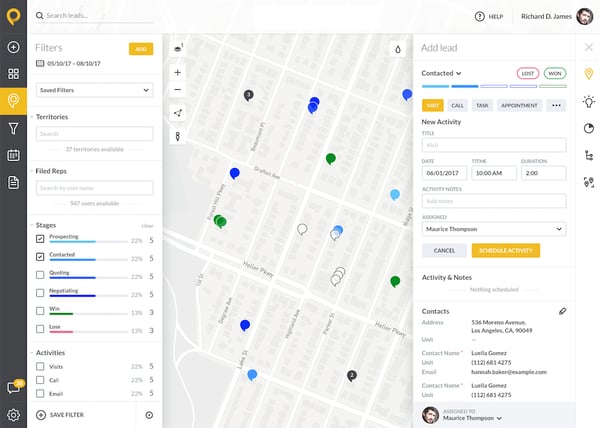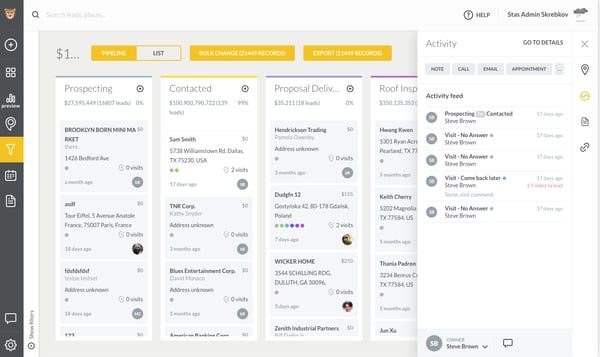April 14, 2020
 by Ryan Dunagan / April 14, 2020
by Ryan Dunagan / April 14, 2020

Every salesperson knows the feeling…
You just finished a meeting with a new prospect and it went great. You sell exactly what they need, and they’re intrigued by the possibility of using your product. You're really excited, and can't wait to hear back with a commitment to purchase.
Only the commitment never comes.
The next day, you get an email telling you that the prospect has decided to "go a different route" or something similar. What went wrong?
A million things could have changed the tides in this situation and prevented you from closing the deal. One of the most likely candidates, though, is that you were simply talking to the wrong person. This is where account mapping comes in handy.
Keep reading to learn what account mapping is, why it's beneficial, and how to do it.
Account mapping, in the broad sense of the phrase, is a sales practice that attempts to uncover exactly what happens behind the scenes at any company a sales rep attempts to sell to.
Today, it takes 6.8 people to sign off on a B2B solutions purchase. This means that sales reps who only communicate with one or two company representatives won't be as effective as they could be because their contacts represent a small portion of the decision-making committee.
A finished account map is a physical representation of all the numerous data points and relationship details that a salesperson needs to know in order to sell to a specific customer.
There are two different kinds of account mapping techniques: individual and partner. Each is beneficial in different ways. The kind you use will depend on your goals.
Individual account mapping is the process of charting a specific company to discover its decision-making hierarchy, partnership network, and more. This is typically done using a standard spreadsheet or data visualization software.
The purpose of individual account mapping is to gain a better understanding of a company's inner-workings so that conversion and retention rates improve. Most of this article will focus on this account mapping strategy.
Partner account mapping is the process of comparing one's customer account information to that of a partner. For example, [Company A] partners with [Business B] and the two organizations exchange details about [Mutual Customer X].
The goal of partner account mapping is to confirm data and discover new relationship information. That way, both companies have as much customer data as possible.
If account mapping sounds like tough, tedious work, that's because it is. But the practice has five incredible benefits that more than make up for the effort you'll put in.
Sales goals, on their own, are often uninspiring to sales reps. A set of numbers is hard to get excited about. Account mapping gives sellers a visualization of their objective, allowing them to better internalize what they need to do, why it's important, and how to do it. When your company's sales associates know the what, why, and how of sales goals, they'll be able to achieve them much more effectively.
One of the biggest mistakes sellers make is not understanding their sales territory potential. If you and your fellow sales associates don't know who your customers are, where they're located (both physically and by industry), their history with your organization, and so on, it will be incredibly difficult to sell to them at a consistent clip.
By mapping accounts, you'll be able to better assess which territories have the most potential for growth and can centralize your efforts on those specific areas.
Account mapping also helps sales teams plan strategically. Once you've dug up in-depth information on your customers, you'll be able to pinpoint the optimal route to a sale, properly map your territories, and accurately visualize your customers.
The right sales presentation delivered to the wrong recipient will result in a missed sales opportunity. Before you close a deal, you have to make sure you're talking to the right decision-maker(s) at the company you're selling to.

An account map will help you determine the best route to a sale, i.e which company representatives are worth your valuable time and which ones you're better off avoiding.
We briefly mentioned territory mapping above. This practice is crucial to your sales planning efforts because it will help you determine select areas of growth for your company. Armed with this information, you can focus your efforts on accounts that have the highest potential.
Knowing who to contact at a prospective company isn't enough. You also need to know how these individuals think, the struggles they deal with on a daily basis, and the goals they hope to achieve. Account mapping helps sales associates visualize their customers and craft personalized sales pitches that have the best chance of finding success.
If we take all of the previous benefits of account mapping and combine them, we're able to improve sales forecasts and better predict future revenue numbers.
It makes sense: when you know who to contact and how, and where these individuals are located, you can expect more accurate conversion rates. You can then use these numbers to better predict your company's future, then plan accordingly.
For example, if you're confident your sales team will close X deals this month resulting in $XX, you can answer important business questions like, "Should we expand into this industry?" and "Are we ready to hire new personnel?" with increased accuracy.
Account mapping helps sales professionals generate new leads. It's simple: because you now know all of the decision makers at a specific company – either through your own research or via partner account mapping techniques – you have more names to contact and sell to.
Not only that, but these new leads will be much easier to engage in conversation. After all, you've already spoken to one of their colleagues and can use this information to get your foot in the door.
Furthermore, if you engage in partner account mapping, you'll also be able to generate new leads from your partner's customers lists, which is one of the biggest benefits to this type of account mapping. Imagine having a stack of quality leads handed to you!
You'll only be able to achieve the five benefits listed above if you learn how to map accounts properly. Fortunately, we have all the information you need. Master these three steps and you'll quickly become an account mapping expert for your organization.
The first step is to import your company's entire database of contacts into one document or software. If you're partnering with other organizations, import their contacts as well.
Make sure each contact has all relevant information. A name and email address alone won't help you much. Instead, do your best to list their position, job description, purchasing power, and their current relationship with your company: known, unknown, friendly, hostile, and so on.
You should be able to find most of these details online. Many companies list team executive names and information on their websites. Public companies will also list information like accounting metrics, revenue numbers, and cost of sales data that might be useful to you as well.
Once you've accumulated enough information and neatly organized it in your CRM software of choice or a designated spreadsheet, you can move on to step two.
By now, you should have a detailed document (or software database) with in-depth information on your company's top prospects. This is your account map. But here's the thing: account maps are pointless if they aren't used. Now is the time to begin strategizing your sales approach by aligning prospecting methods with specific accounts.

For example, you might contact John at The Big Corporation, only to realize that he's actually the assistant to Craig. Since Craig is the one who makes all buying decisions, you'll want to aim your sales presentations at him, not John. Now that you know this crucial detail, be sure to add it to your account map for future reference.
You can save your sales team some time by using a CRM tool for your account mapping efforts instead of a spreadsheet. If you do, you'll be able to assign all new leads with a unique tag in your software of choice, marking them as a specific kind of buyer and recommending a preferred selling approach for the future.
It's important to continually monitor your account mapping efforts. How are you and your team using the information your map contains. Are your efforts meeting with success? If not, it's probably time to adjust your strategy.
Here are a couple of ideas to help you better utilize your account map:
Now that your account map is built, you can use it to develop future sales strategies. For instance, you can begin to better prioritize accounts, pinpoint contacts, and visualize the entire sales pipeline. We encourage you to make account mapping part of your sales process.
Like all things, account mapping is fraught with potential pitfalls. Here are a few of the most common mistakes to avoid when mapping accounts for your company.
This is one of the biggest account mapping mistakes. When your sales team focuses on the wrong people, i.e. people without decision-making power or just a small section of decision-makers within a specific organization, it will be difficult to make sales.
Fortunately, this is exactly what account mapping is designed to help you avoid. Dig deep into your customer data and make sure you're contacting the right people at each company you engage in sales conversations.
Another common mistake in regards to account mapping is not standardizing your process. You and your team should develop a system for discovering client details and adding them to your CRM software. That way, important information is always found and added in the same way and your entire sales team can use the resource effectively.
The average person changes jobs 12 times during their career. This means that if you don't update your account map on a regular basis, it will quickly become irrelevant. All the details on a company's decision makers won't benefit you if said decision maker is now working for a different organization. Take the time to regularly go through your account map and ensure all the information it contains is up-to-date and accurate.
To find the most success with account mapping, be sure to keep these best practices and top tips in mind as you create and update your map.
While this may seem obvious, commitment is the first step towards successful account mapping. If you and your team aren't dedicated to sourcing customer information, inputting it into your account map, and updating the resource on a regular basis, it won't help you.
We encourage you to decide right now whether account mapping is something you want to invest in. If that answer is yes, commit. If it's no, find a different sales tactic to spend your company's time and resources on.
A strategic account is a customer or client who contributes more revenue and/or referrals to your company than most others. These are your raving fans.
It's important to identify these accounts in your account map because they're the most important ones to your organization. When you understand who they are, you can work to keep them happy by offering them new products and services you know they'll enjoy, occasional discounts, and anything else you deem appropriate.
Lastly, we suggest that you use the right tools when mapping accounts. While a simple spreadsheet can work, a powerful CRM tool will be much more effective. You may also consider investing in a data visualization for sales software solution. Like anything else, the right tools will enable your sales team to work more productively and achieve greater success.
Account mapping is a useful sales strategy that will help your company visualize sales goals, understand territory potential, plan its sales approach effectively, improve forecasting and revenue, and generate new leads.
Fortunately, it's not rocket science — as long as you follow the three steps we outlined in this article:
We encourage you to give account mapping a try today! We're confident that this sales strategy will completely revolutionize your company's approach to selling.
While you're at it, learn 67 types of data visualization you should be implementing as part of your account mapping strategy.
Ryan Dunagan is the VP of Marketing at SPOTIO, a mobile-first solution for outside sales teams to eliminate guesswork and focus on the highest impact activity. His expertise lies in leading marketing teams at hyper-growth B2B SaaS companies.
Customer journeys are becoming complex, and it's no surprise.
 by Jeremy Sacramento
by Jeremy Sacramento
Maps are one of the most effective ways to present data. They display where we live, where we...
 by Michael Gigante
by Michael Gigante
Would you rather be addressed as “Hey there” or by your name?
 by Claire Brenner
by Claire Brenner
Customer journeys are becoming complex, and it's no surprise.
 by Jeremy Sacramento
by Jeremy Sacramento
Maps are one of the most effective ways to present data. They display where we live, where we...
 by Michael Gigante
by Michael Gigante


